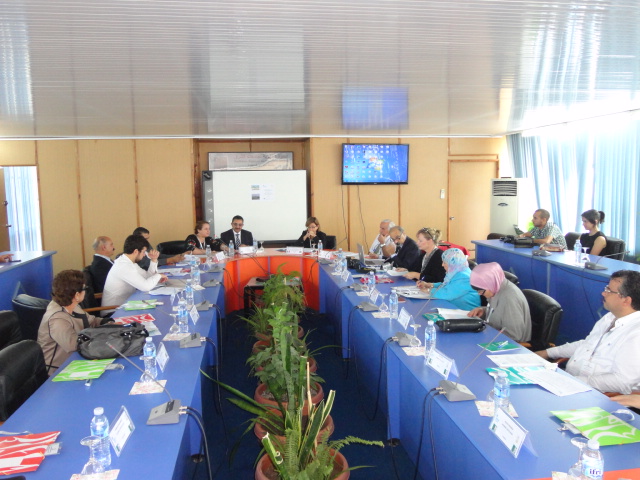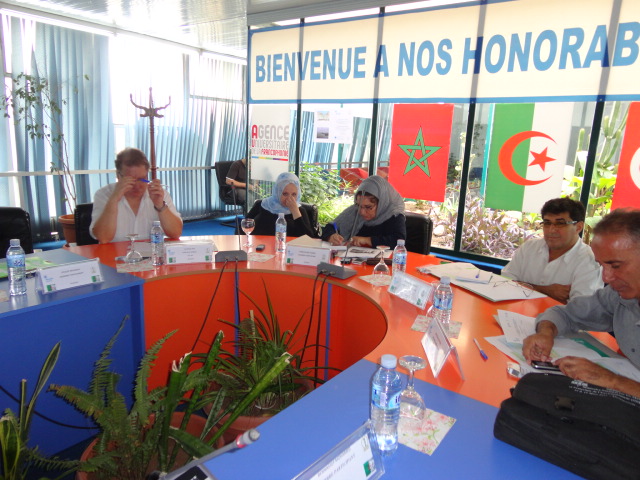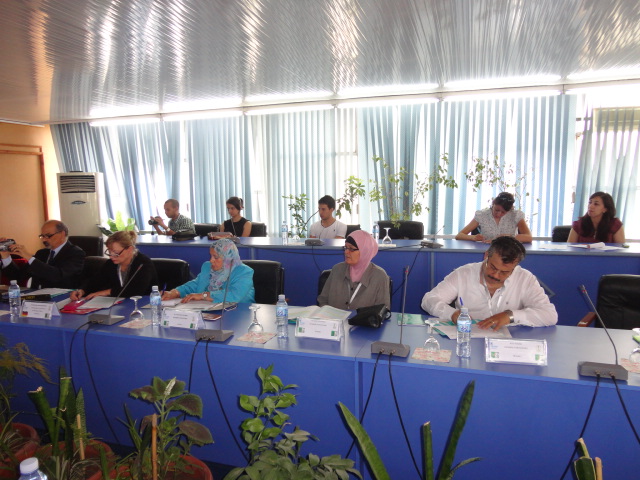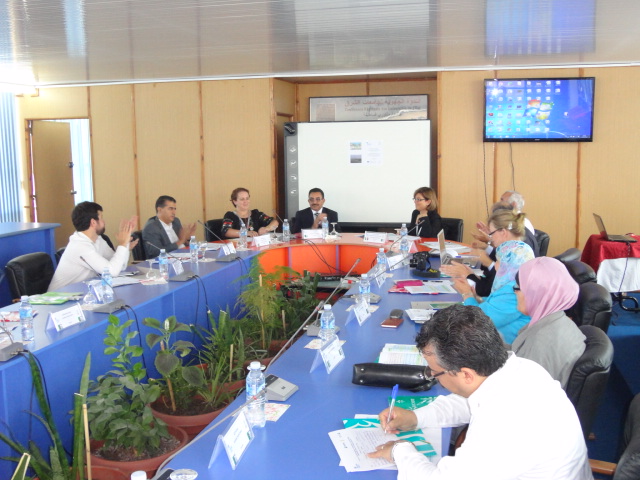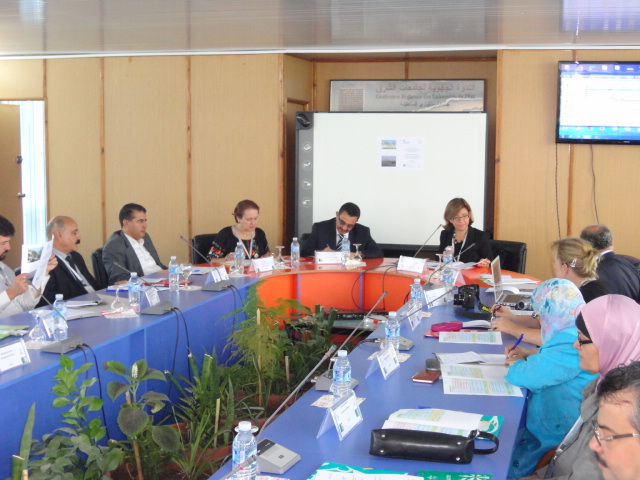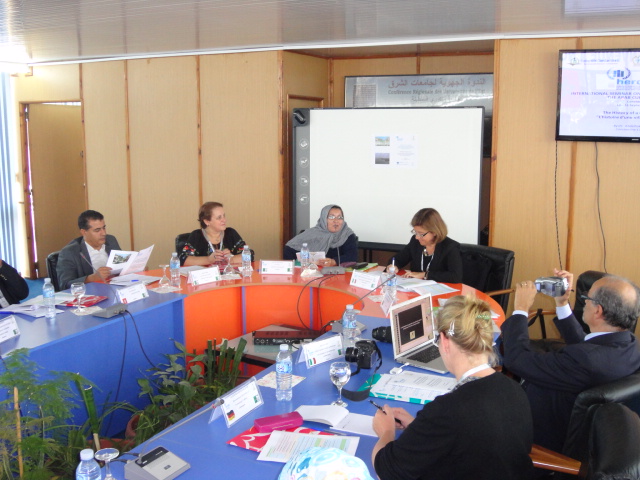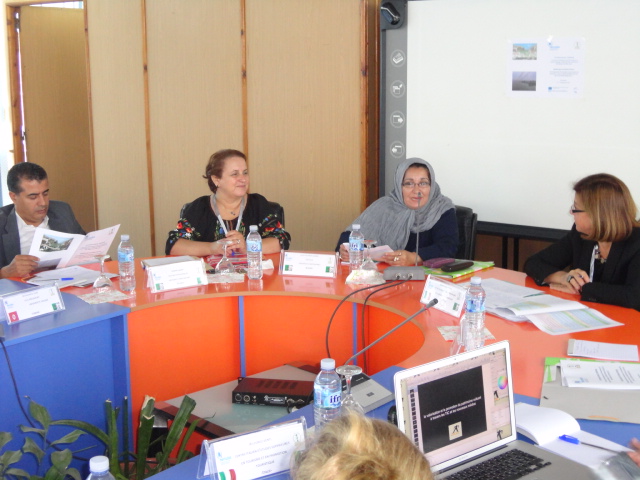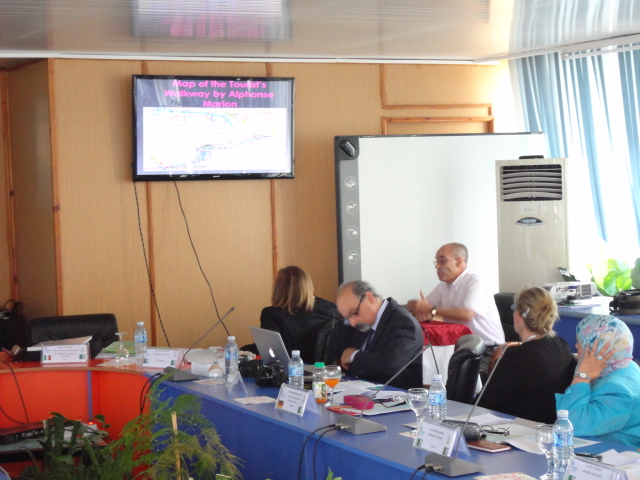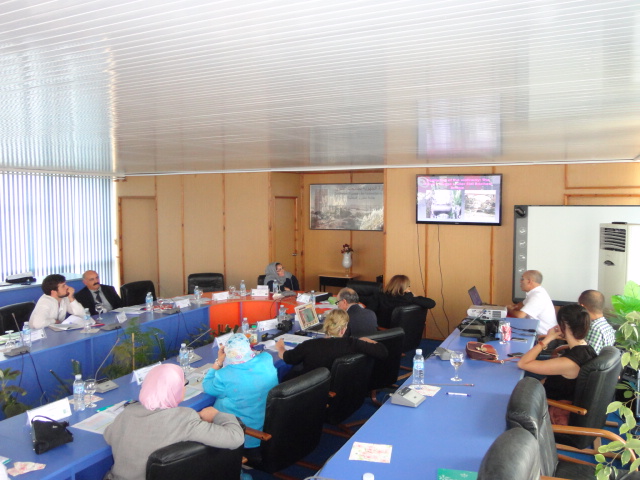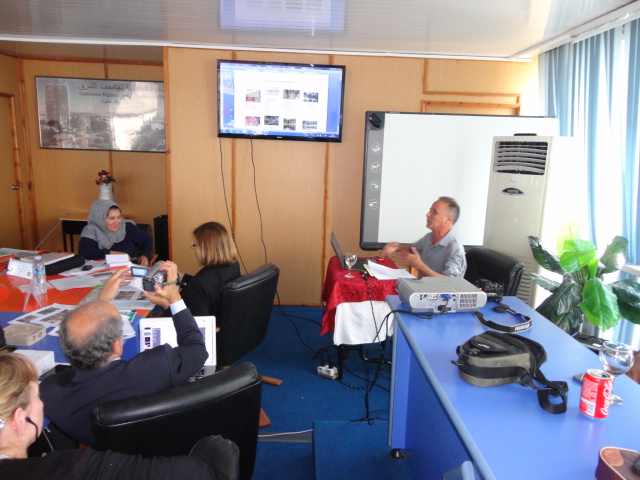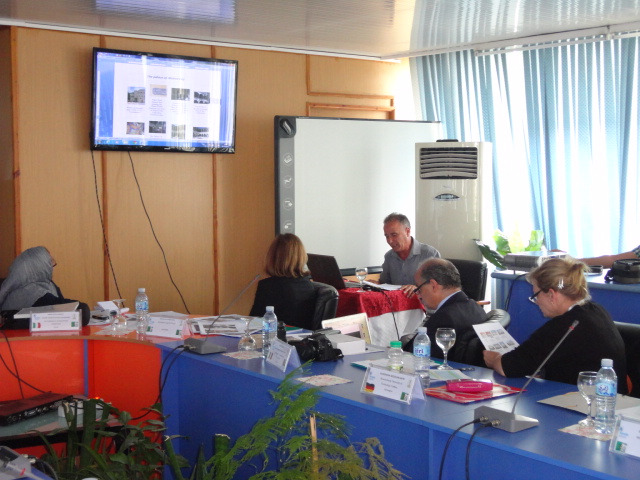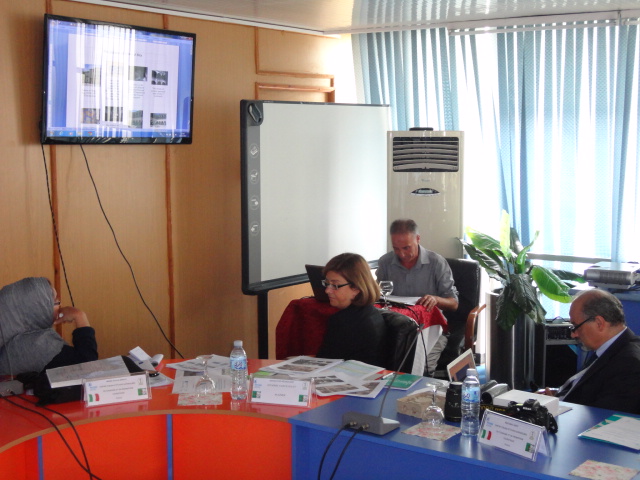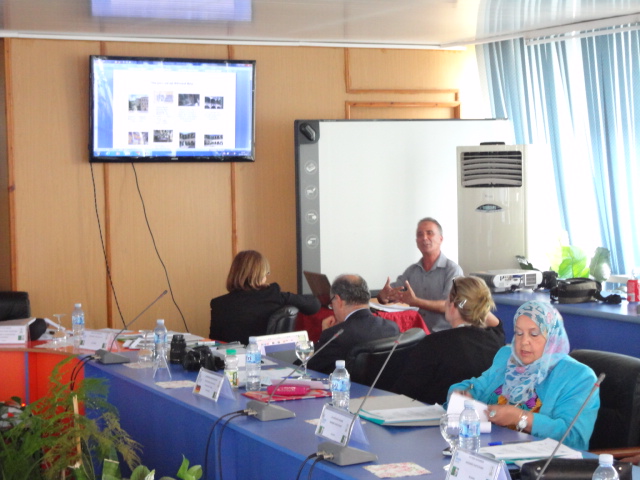CIPSA 2013 Recueil des résumés
La 9ième Conférence Internationale en Physique Subatomique et Applications (CIPSA2013) organisée par le Laboratoire de Physique Mathématique et Subatomique (LPMS) sous le patronat de l’Université Constantine-1 et le haut patronat du Ministère de l’Enseignement Supérieur et de la Recherche Scientifique, est un événement scientifique ayant pour objectifs, de réunir les chercheurs et les doctorants de tout Horizon. Cette rencontre leurs permettra d’échanger les idées, les connaissances, de discuter sur leurs recherches et perspectives, et aussi de créer des collaborations nationales et internationales.
CIPSA 2013 Recueil des résumés
La 9ième Conférence Internationale en Physique Subatomique et Applications (CIPSA2013) organisée par le Laboratoire de Physique Mathématique et Subatomique (LPMS) sous le patronat de l’Université Constantine-1 et le haut patronat du Ministère de l’Enseignement Supérieur et de la Recherche Scientifique, est un événement scientifique ayant pour objectifs, de réunir les chercheurs et les doctorants de tout Horizon. Cette rencontre leurs permettra d’échanger les idées, les connaissances, de discuter sur leurs recherches et perspectives, et aussi de créer des collaborations nationales et internationales.
Rhizosphere bacteria help plants tolerate abiotic stress
Jungwook Yang1, Joseph W. Kloepper2 and Choong-Min Ryu1,3
1Systems Microbiology Research Center, Korea Research Institute of Bioscience and Biotechnology (KRIBB), Daejeon 305-806, South Korea
2Department of Entomology and Plant Pathology, Auburn University, Auburn, AL 36849, USA
3Field of Functional Genomics, University of Science and Technology, Daejeon 305-666, South Korea
Plant-growth-promoting rhizobacteria (PGPR) are associated with plant roots and augment plant pro-ductivity and immunity; however, recent work by
several groups shows that PGPR also elicit so-called ‘induced systemic tolerance’ to salt and drought. As we discuss here, PGPR might also increase nutrient uptake from soils, thus reducing the need for fertilizers and preventing the accumulation of nitrates and phos- phates in agricultural soils. A reduction in fertilizer use would lessen the effects of water contamination from fertilizer run-off and lead to savings for farmers.
Introduction Plant-growth-promoting rhizobacteria (PGPR) colonize the rhizosphere of many plant species and confer beneficial effects, such as increased plant growth and reduced susceptibility to diseases caused by plant pathogenic fungi, bacteria, viruses and nematodes [1]. Some PGPR also elicit physical or chemical changes related to plant defense, a process referred to as ‘induced systemic resistance’ (ISR)
[2]. ISR elicited by PGPR has suppressed plant diseases caused by a range of pathogens in both the greenhouse and
field [1,2]. However, fewer reports have been published on PGPR as elicitors of tolerance to abiotic stresses, such as
drought, salt and nutrient deficiency or excess. The subject of PGPR-elicited tolerance to heavy metals has been
reviewed recently [3,4], so it is excluded from this discus-sion. Here, we propose the term ‘induced systemic toler- ance’ (IST) for PGPR-induced physical and chemical changes in plants that result in enhanced tolerance to abiotic stress, and we review recently published work
related to this subject. Biotic stress is excluded from IST because conceptually it is part of biological control and
induced resistance.
Bacterial effects on thirsty plants Drought stress limits the growth and productivity of crops, particularly in arid and semi-arid areas [5]. Early studies
on IST to drought [6] reported that inoculation with the PGPR Paenibacillus polymyxa enhanced the drought tol-erance of Arabidopsis thaliana. RNA differential display on parallel RNA preparations from P. polymyxa-treated and untreated plants revealed that mRNA transcriptions of a drought-response gene, EARLY RESPONSIVE TO DEHYDRATION 15 (ERD15), were also augmented.
Another PGPR strain, Achromobacter piechaudii ARV8, Corresponding author: Ryu, C.-M. (Cette adresse e-mail est protégée contre les robots spammeurs. Vous devez activer le JavaScript pour la visualiser.).
which produces 1-aminocyclopropane-1-carboxylate (ACC) deaminase, conferred IST to drought stress in pepper (Capsicum annuum L.) and tomato (Solanum lycopersicum L.) plants [7]. Under stress conditions, including drought, the plant hormone ethylene endogenously regulates plant homeostasis and results in reduced root and shoot growth [8]. However, degradation of the ethylene precursor ACC
by bacterial ACC deaminase releases plant stress and rescues normal plant growth [8].
Recent efforts to apply these results to greenhouse and field situations include using mixtures of PGPR strains with symbiotic nitrogen-fixing rhizobia [9] or with mycor-rhizal fungi [10]. The rhizobia are sensitive to drought stress, resulting in a significant decrease of N2 fixation when faced with low soil-water content. Under drought stress, co-inoculation of bean (Phaseolus vulgaris L.) with Rhizobium tropici and two strains of P. polymyxa resulted
in augmented plant height, shoot dry weight and nodule number [9]. Interestingly, the effect on IST and increased nodule number was greater when a mix of two strains of P. polymyxa was applied than when one strain was applied, suggesting some synergistic effects from the use of strain
mixtures.
Investigations into how drought stress affects plant hormone balance revealed an increase in abscisic acid (ABA) content in the leaves, indicating that the reduction of endogenous cytokinin levels magnifies ABA content, eliciting stomata closure [9,11] (Figure 1). The cytoki-nin–ABA antagonism might be the result of metabolitic interactions because they share a common biosynthetic origin [11]. It will be interesting to determine whether cytokinin produced by P. polymyxa affects ABA signaling of plants or rhizobia-elicited nodulation [6,9].
Co-inoculation of lettuce (Lactuca sativa L.) with PGPR Pseudomonas mendocina and arbuscular mycorrhizal fungi (Glomus intraradices or G. mosseae) augmented an antioxidant catalase under severe drought conditions, suggesting that they can be used in inoculants to alleviate
the oxidative damage elicited by drought [10] (Figure 1).
Help from bacteria for salty plants Soil salinity in arid regions is frequently an important limiting factor for cultivating agricultural crops. Although
many technologies have been implicated in the improve-ment of salt tolerance, only PGPR-elicited plant tolerance against salt stress has been previously studied. In one study [12] the ethylene content in tomato seedlings exposed to high salt was reduced by application of Achro-
mobacter piechaudii, indicating that bacterial ACC dea-1Update
Trends in Plant Science Vol.14 No.1
Figure 1. IST elicited by PGPR against drought, salt and fertility stresses underground (root) and aboveground (shoot). Broken arrows indicate bioactive compounds
secreted by PGPR; solid arrows indicate plant compounds affected by bacterial components. Some PGPR strains, indicated in red on the plant roots, produce cytokinin and
antioxidants such as catalase, which result in ABA accumulation and ROS degradation, respectively [9,10]. Degradation of the ethylene precursor ACC by bacterial ACC
deaminase releases plant stress and rescues normal plant growth under drought and salt stresses [10,12]. The volatiles emitted by PGPR downregulate hkt1 expression in
roots but upregulate it in shoot tissues, orchestrating lower Na+ levels and recirculation of Na+ in the whole plant under high salt conditions [13]. Production by PGPR of IAA
or unknown determinants can increase root length, root surface area and the number of root tips, leading to enhanced uptake of nitrate and phosphorous [16–18].
Abbreviations: ABA, abscisic acid; ACC, 1-aminocyclopropane-1-carboxylate; HKT1, high-affinity K+ transporter 1; IAA, indole acetic acid; IST, induced systemic tolerance;
PGPR, plant-growth-promoting rhizobacteria; ROS, reactive oxygen species.
minase was functional. A. piechaudii, which produces
ACC, increased the growth of tomato seedlings by as much
as 66% in the presence of high salt contents. IST to salt
stress was also noted in a new study with Arabidopsis [13]
using Bacillus subtilis GB03, a species that has previously
been used as a commercial biological control agent. Inter-
estingly, some of the volatile organic compounds (VOCs)
that are emitted from B. subtilis GB03 [14] (Figure 1) are
bacterial determinants involved in IST.
Among the 600 Arabidopsis genes isolated by transcrip-
tome analysis, transcriptional expression of HIGH-AFFI-
NITY K+ TRANSPORTER 1 (HKT1), which controls Na+
import in roots, was decreased. HKT1 has been shown to
adjust Na+ and K+ levels differentially, depending on the
plant tissue. Exposure of an athkt1 mutant to bacterial
VOCs not only resulted in typical salt-stress phenotypes,
such as stunting, but also led to the inhibition of seedling
growth. Transcriptional validation revealed that bacterial
VOCs downregulated HKT1 expression in roots, but upre-
gulated it in shoot tissues, thereby orchestrating lower Na+
levels in the whole plant. Furthermore, there is no differ-
ence in IST to salt stress in the Na+-export mutant salt
overly sensitive3 (sos3), suggesting that HKT1 functions in
shoots to retrieve Na+ from the xylem, thereby facilitating
shoot-to-root Na+ recirculation. Overall, plant perception
2
of bacterial VOC causes a tissue-specific regulation of
HKT1 that controls Na+ homeostasis under salt stress.
Bacterial help with fertility and nutrient uptake
Another abiotic stress that plants face is obtaining ad-
equate soil nutrients. Although soil fertilization is typically
required for agricultural production, it can cause nitrate
and phosphate accumulation that eventually contaminates
surface and ground waters. Phosphate run-off is associated
with eutrophication of surface waters, resulting in
increased fish mortality [15]; in addition, nitrogen run-
off from US agriculture into the Mississippi River is linked
to oxygen starvation in the Gulf of Mexico, creating ‘dead
zones’ where shrimp and fish populations are greatly
reduced [15]. These environmental impacts of fertilization
can be attributed, in part, to low uptake efficiency by crops.
For example, phosphorous is highly reactive with iron,
aluminium and calcium in soils, which can result in pre-
cipitation of up to 90% of the soil phosphorous [16], thus
making it largely unavailable to plants.
PGPR have promise as components in approaches for
maintaining adequate plant nutrition and reducing the
negative environmental effects of fertilizers. Plant growth
promotion by some PGPR has been associated with the
solubilization and increased uptake of phosphate [16].Update
PGPR have also been reported to affect nitrate uptake by
plants [17,18].
In addition to causing increases in general plant growth,
some PGPR promote root development [17] and alter root
architecture by the production of phytohormones such as
indole acetic acid (IAA) [19] (Figure 1), resulting in
increased root surface area and numbers of root tips. Such
stimulation of roots can aid plant defense against patho-
gens and can also relate to IST. Given that root tips and
root surfaces are sites of nutrient uptake, it is likely that
one mechanism by which PGPR lead to increased nutrient
uptake is via stimulation of root development. It has also
been suggested that PGPR increase plant uptake of
mineral ions via stimulation of the proton pump ATPase
[17], although experimental evidence for this is lacking.
Owing to the environmental problems discussed above
and the increasing prices of fertilizers, there is a push
from farmers worldwide to reduce fertilizer levels below
those recommended for optimum yields; however, such
reductions would represent an abiotic stress on plants.
Hence, several studies are now testing the hypothesis that
PGPR might enable agricultural plants to maintain pro-
ductivity with reduced rates of fertilizer application, and
the preliminary results are promising. For example, in one
field study with wheat (Triticum aestivum L.) [20], the
yield for plants that were given 75% of the recommended
amount of N-P-K fertilizer plus a PGPR strain was equiv-
alent to the yield for plants that were given the full amount
of fertilizer but without PGPR. In another study on tomato
[21], the dry weight of tomato transplants grown in the
greenhouse was significantly greater with two PGPR
strains and 75% fertilizer than with the full amount of
fertilizer and without PGPR; after transplanting to the
field, yields with some combinations of PGPR and mycor-
rhizal fungi at 50% recommended field fertilization were
greater than the yield of the 100% fertilizer control without
microbes.
Another current hypothesis is that PGPR, used as com-
ponents of integrated nutrient management systems, can
help reduce the build up of nutrients in fertilized soils.
Support for this hypothesis was presented in a recent
report [18] of a three-year field study on maize that eval-
uated PGPR with and without mycorrhizal fungi, manure
and inorganic fertilizer, as well as with and without tillage.
Significant increases in grain yield from microbial treat-
ments were accompanied by increased nitrogen content per
gram of grain tissue and removal of significantly higher
amounts of nitrogen, phosphorous and potassium. There-
fore, within the tested nutrient management system,
PGPR contributed significantly to reducing nutrient build
up in the soil. Many current studies are underway that will
further define the utility of PGPR in nutrient management
strategies aimed at reducing fertilizer application rates
and nutrient runoff from agricultural sources.
Perspectives
PGPR-elicited IST can aid the growth of crops in envir-
onmentally unfavorable conditions. More investigations
into the mechanisms by which PGPR elicit tolerance to
specific stress factors should improve the use of IST
in agriculture by enabling the optimization of microbial
Trends in Plant Science
Vol.14 No.1
mixtures for the production of specific bacterial determi-
nants (e.g. cytokinin, antioxidants, ACC deaminase, VOCs
and IAA).
Improved plant nutrition with PGPR might or might not
be due to IST as defined here. For example, if increased
nutrient content in plants results from enhanced nutrient
uptake, IST is operable because physical or chemical
changes in the plant caused by PGPR are ultimately respon-
sible, as occurs when PGPR stimulate root development.
However, PGPR could increase nutrient availability with-
out directly affecting plants. Although this would also result
in greater nutrient levels in plants, it would not be explained
by IST. Future investigations into each case where PGPR
affect plant nutrition will elucidate this point.
The field of PGPR-elicited ISR should now focus on two
directions. First, more studies are needed to demonstrate
that PGPR cause a range of crops to be tolerant to various
environmental stresses. In addition, studies are needed to
elucidate the signal transduction pathways that result
from treatment of plants with PGPR under stress con-
ditions. Only then will the full benefits of PGPR be under-
stood.
Acknowledgements
́rez for critical reading and valuable comments on
We thank Camilo Ramı
the article. Financial support was received from the 21C Frontier
Microbial Genomics and Application Center Program, Ministry of
Education, Science and Technology, Biogreen21, Rural Development
Administration, Agricultural R and D Promotion Center (ARPC) and
KRIBB initiative program, South Korea.
References
1 Kloepper, J.W. et al. (2004) Induced systemic resistance and promotion
of plant growth by Bacillus species. Phytopathology 94, 1259–1266
2 van Loon, L.C. et al. (2004) Systemic resistance induced by rhizosphere
bacteria. Annu. Rev. Phytopathol. 36, 453–483
3 Zhuang, X. et al. (2007) New advances in plant growth-promoting
rhizobacteria for bioremediation. Environ. Int. 33, 406–413
4 Glick, B.R. (2003) Phytoremediation: synergistic use of plants and
bacteria to clean up the environment. Biotechnol. Adv. 21, 383–393
5 Kramer, P.J. and Boyer, J.S. (1995) Water Relations of Plants and Soils.
American Press
6 Timmusk, S. and Wagner, G.H. (1999) The plant-growth-promoting
rhizobacterium Paenibacillus polymyxa induces changes in
Arabidopsis thaliana gene expression: a possible connection between
biotic and abiotic stress responses. Mol. Plant Microbe Interact. 12,
951–959
7 Mayak, S. et al. (2004) Plant growth-promoting bacteria that confer
resistance to water stress in tomatoes and peppers. Plant Sci. 166, 525–
530
8 Glick, B.R. et al. (2007) Promotion of plant growth by bacterial ACC
deaminase. Crit. Rev. Plant Sci. 26, 227–242
9 Figueiredo, V.B. et al. (2008) Alleviation of drought stress in the
common bean (Phaseolus vulgaris L.) by co-inoculation with
Paenibacillus polymyxa and Rhizobium tropici. Appl. Soil Ecol 40,
182–188
10 Kohler, J. et al. (2008) Plant-growth-promoting rhizobacteria and
arbuscular mycorrhizal fungi modify alleviation biochemical
mechanisms in water-stressed plants. Funct. Plant Biol. 35, 141–151
11 Cowan, A.K. et al. (1999) Regulation of abscisic acid metabolism:
towards a metabolic basis for abscisic acid-cytokinin antagonism. J.
Exp. Bot. 50, 595–603
12 Mayak, S. et al. (2004) Plant growth-promoting bacteria confer
resistance in tomato plants to salt stress. Plant Physiol. Biochem.
42, 565–572
13 Zhang, H. et al. (2008) Soil bacteria confer plant salt tolerance by
tissue-specific regulation of the sodium transporter HKT1. Mol. Plant
Microbe Interact. 21, 737–744
3Update
Trends in Plant Science Vol.14 No.1
14 Ryu, C-M. et al. (2004) Bacterial volatiles induce systemic resistance in
Arabidopsis. Plant Physiol. 134, 1017–1026
15 Malakoff, D. (1998) Coastal ecology: death by suffocation in the Gulf of
Mexico. Science 281, 190–192
16 Gyaneshwar, P. et al. (2002) Role of soil microorganisms in improving P
nutrition of plants. Plant Soil 245, 83–93
17 Mantelin, S. and Touraine, B. (2004) Plant growth-promoting bacteria
and nitrate availability impacts on root development and nitrate
uptake. J. Exp. Bot. 55, 27–34
18 Adesemoye, A.O. et al. (2008) Enhanced plant nutrient use efficiency
with PGPR and AMF in an integrated nutrient management system.
Can. J. Microbiol. 54, 876–886
19 Kloepper, J.W. et al. (2007) Photoperiod regulates elicitation of growth
promotion but not induced resistance by plant growth-promoting
rhizobacteria. Can. J. Microbiol. 53, 159–167
20 Shaharoona, B. et al. (2008) Fertilizer-dependent efficiency of
pseudomonads for improving growth, yield, and nutrient use efficiency
of wheat (Triticum aestivum L). Appl. Microbiol. Biotechnol. 79, 147–155
́ ndez, M. and Chailloux, M. (2004) Las microrizas arbusculares y
21 Herna
́ricas como alternativa a la nutricio
́ n mineral del
las bacterias rizosfe
tomate. Cultivos Tropicales 25, 5–16
1360-1385/$ – see front matter ß 2008 Elsevier Ltd. All rights reserved.
doi:10.1016/j.tplants.2008.10.004 Available online 4 December 2008
Plant Science Conferences in 2009
Plant Abiotic Stress Tolerance
8-11 February 2009
Vienna, Austria
http://www.univie.ac.at/stressplants/
Adaptation Potential in Plants
19-21 March 2009
Vienna, Austria
http://www.gmi.oeaw.ac.at/en/other-sites/febs/home/
IUBMB Special Meeting on Plant Stresses & 6th Congress of FASBMB
20–25 April 2009
Marrakech, Morocco
http://www.smbbm.org/specialMeeting2009/meeting-socialProgram.html
5th Meeting of the IOBC Working Group
‘‘Induced Resistance in Plants against Insects and Diseases’’
12–16 May 2009
Granada, Spain
http://www.fvccee.uji.es/
5th Symposium on Plant Neurobiology
25–29 May 2009
Florence, Italy
http://www.5thspnb.org/
Selon Amar Ghoul: Le Transrhumel livré en avril 2014
En visite d'inspection et de travail hier à Constantine, le ministre des Travaux publics, M. Amar Ghoul, a procédé à l'inauguration du tronçon constantinois de l'autoroute Est-Ouest reliant la localité d'El-Méridj à la commune de Zighoud-Youcef via le premier tunnel de Djebel Ouahch d'une longueur de 1,9 kilomètre qui a été achevé. L'ouverture à la circulation automobile du même tronçon, mais dans le sens opposé, se fera au cours du mois d'octobre prochain, a annoncé le ministre en expliquant, sans plus de détails, que ce retard relève de mesures sécuritaires préventives. Dans le sillage de cette inauguration, M. Ghoul a donné les recommandations d'usage aux responsables du consortium algéro-japonais de Cojaal et ceux de l'Agence nationale des autoroutes leur enjoignant de planter des arbustes sur les deux côtés de la voie rapide pour prévenir les glissements de terrain qui pourraient menacer la voie et remettre en cause tout le travail qui a été fait. Il ordonna aux mêmes responsables de veiller à l'accélération de la réalisation des infrastructures d'accompagnement du projet pour rendre aisée et agréable son utilisation par les citoyens et les automobilistes.
En ce qui concerne le tronçon de l'autoroute reliant Zighoud-Youcef à El-Harrouch, dans la wilaya de Skikda, long de 25 kilomètres, M. Ghoul a recommandé aux responsables du chantier d'œuvrer H24 pour rattraper le retard et terminer les travaux dans les délais impartis. Pour clore ce chapitre, le ministre des Travaux publics a indiqué qu'il ne reste plus que 2% du projet de l'autoroute Est-Ouest à réaliser et que son achèvement total est dans peu de temps.
Prenant la parole au cours de la cérémonie officielle d'inauguration, M. Ghoul est revenu sur le programme du président de la République en matière de développement des infrastructures de base en rappelant notamment qu'en 2003, le réseau des voies rapides en Algérie ne dépassait pas les 300 kilomètres. «Aujourd'hui nous avons dépassé 4700 km, a-t-il dit, et dans les prochaines années nous allons atteindre les 8000 km. Ce qui fera de l'Algérie le premier pays africain disposant d'un réseau de voies rapides aussi dense». De retour de son périple, le ministre s'est arrêté sur le chantier de construction du Transrhumel, au niveau de la base du Bardo et du Chalet des Pins. Au moyen de l'ascenseur accolé à l'ouvrage, M. Ghoul est monté sur le pilon n°3 qui vient d'être achevé et au sommet duquel flottaient les drapeaux de l'Algérie et du Brésil. En descendant visiblement satisfait de l'avancée réalisée dans ce chantier, il a déclaré que le viaduc sur le Rhumel sera achevé à la fin de l'année en cours, mais le projet complet, avec les voies pénétrantes et la connexion qui sera réalisée avec l'autoroute Est-Ouest au niveau de Djebel Ouahch sera livré au cours des mois de mars ou avril 2014.
Développement du tourisme et valorisation du patrimoine culturel
l'université Constantine 1 organise les 10 et 11 septembre 2013, avec l'appui du consortium du projet Européen ERASMUS-MENDUS (HERCULES) un séminaire internatioonal intitulé :
